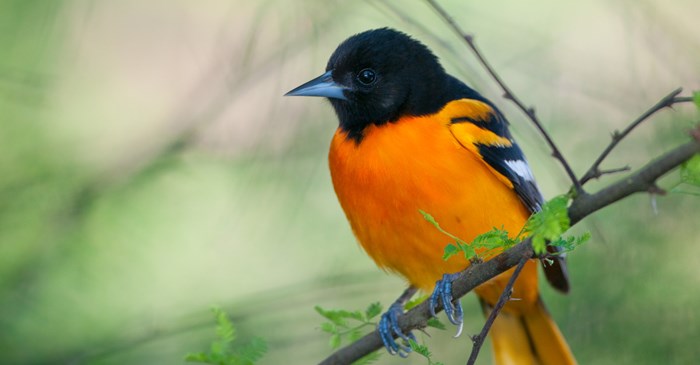The sweet song of the Baltimore Oriole has delighted backyard birders for generations. Here’s a look at some fun facts about these active and lively orange and black birds.
- The Baltimore Oriole is one of nine oriole species found throughout North America. Other common species include the look-alike Bullock’s Oriole, the orange-headed Hooded Oriole, the Orchard Oriole and the bright yellow and black Scott’s Oriole.
- When it comes to nest making it’s hard to match the weaving skills of the oriole. They weave strands of grasses, milkweed and other plant fibers to create hanging nests from the tops of deciduous trees. If you’re lucky enough to view this construction from a safe distance (a pair of binoculars might be handy) you can watch a female at work, poking her beak through the nest structure to grab the end of a long strand of grass, then pushing it back in to complete the weave. It can take her two weeks to complete the soft but sturdy hanging sock which will cradle her eggs and protect them from pests and predators.
- In the fall, the Baltimore Oriole has a nearly insatiable appetite for ripe, sweet fruits, which provide them the ready source of energy they need to help them migrate to Central America for the winter. They’re capable of clearing your harvest of cherries, grapes, oranges and raspberries. Bird netting offers gardens protection against these hungry orioles and other fruit-eating birds. It can also help to know that orioles steer clear of light-colored fruit, like green grapes and yellow cherries.
- For the rest of the growing season, these birds become a friend to gardeners by actively foraging caterpillars and other flying insects that can be harmful to gardens. The birds will hang upside down from twigs while hunting around the leaves and bark for their meal. They even find their meals by catching insects mid-flight.
- Orioles are well adapted to parks and tree-filled neighborhoods. While they don’t eat seeds and nuts from a bird feeder, you can get a closer look at these beautiful birds by setting out small amounts of dark fruit jelly or hanging orange halves from a tree.
In addition to the Baltimore Oriole, North America is home to many colorful bird species. To attract them to your yard, set out plenty of fresh water and high quality food that they love to eat. Lyric Delite No-Waste Mix offers a tasty blend of shelled seeds and nuts that many of these bird species will love. With this no waste mix, you can experience the joy of up-close bird watching without the mess of shells.
